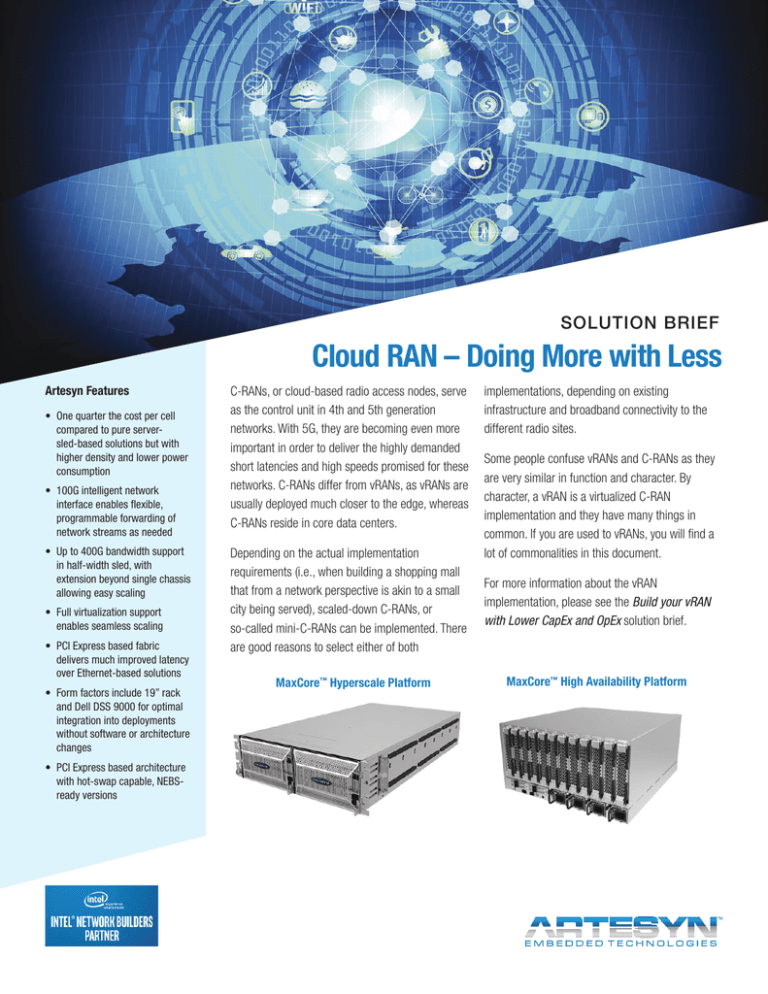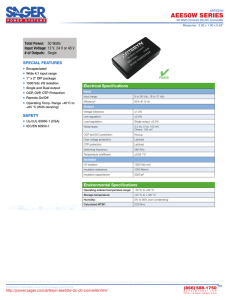
SOLUTION BRIEF
Cloud RAN – Doing More with Less
Artesyn Features
• One quarter the cost per cell
compared to pure serversled-based solutions but with
higher density and lower power
consumption
• 100G intelligent network
interface enables flexible,
programmable forwarding of
network streams as needed
• Up to 400G bandwidth support
in half-width sled, with
extension beyond single chassis
allowing easy scaling
• Full virtualization support
enables seamless scaling
• PCI Express based fabric
delivers much improved latency
over Ethernet-based solutions
• Form factors include 19” rack
and Dell DSS 9000 for optimal
integration into deployments
without software or architecture
changes
• PCI Express based architecture
with hot-swap capable, NEBSready versions
C-RANs, or cloud-based radio access nodes, serve
as the control unit in 4th and 5th generation
networks. With 5G, they are becoming even more
important in order to deliver the highly demanded
short latencies and high speeds promised for these
networks. C-RANs differ from vRANs, as vRANs are
usually deployed much closer to the edge, whereas
C-RANs reside in core data centers.
Depending on the actual implementation
requirements (i.e., when building a shopping mall
that from a network perspective is akin to a small
city being served), scaled-down C-RANs, or
so-called mini-C-RANs can be implemented. There
are good reasons to select either of both
MaxCore™ Hyperscale Platform
implementations, depending on existing
infrastructure and broadband connectivity to the
different radio sites.
Some people confuse vRANs and C-RANs as they
are very similar in function and character. By
character, a vRAN is a virtualized C-RAN
implementation and they have many things in
common. If you are used to vRANs, you will find a
lot of commonalities in this document.
For more information about the vRAN
implementation, please see the Build your vRAN
with Lower CapEx and OpEx solution brief.
MaxCore™ High Availability Platform
Implementation of a C-RAN
The actual implementation of a C-RAN is based on the same
MaxCore™ architecture that was already demonstrated for the
vRAN implementation, just in a different form factor. To operators
and telecom equipment manufacturers (TEMs), this offers the
major advantage of reuse of their implementation on one of these
architectures, when moving to another one. The MaxCore
architecture carries the same capability and “use and feel”
across the different form factors. It also shows the same lowestpossible latencies that are required due to its use of PCI Express
as the internal fabric rather than Ethernet. In this implementation,
the MaxCore™ Hyperscale implementation is in the form of a
sled that integrates into the Dell DSS 9000 racks.
The Artesyn MaxCore Hyperscale product – built around the
Intel® Xeon® D processor family and paired with the Artesyn
Silver Lining™ virtualization software – creates an unprecedented
level of both density and versatility when building virtualized
C-RAN implementations.
C-RAN Diagram
With up to 338 processor cores and up to 400G bandwidth
support, a single MaxCore Hyperscale half-width sled can support
approximately 4x more cells (using today’s L1 technology), in a
compressed footprint and with a fraction of the power and cooling
costs compared with a traditional sled approach, with resulting
OpEx and CapEx savings. Virtualization techniques, paired with the
latest I/O capabilities, enable short update cycles and remove
potential bottlenecks in the hardware space that could hamper the
success of these upgrades.
Capabilities and Architecture
By combining an off-the-shelf architecture with the unique
ExpressFabric™ technology, the MaxCore Hyperscale platform
allows consolidation of what would traditionally require multiple
server sleds into a single appliance. With the ability to expand
across multiple chassis and share central resources such as the
100G intelligent network interface cards, the MaxCore Hyperscale
platform also removes the need for multiple top-of-rack (TOR)
switches and combines all this into a single system configuration.
I/O can easily be added using standard PCI Express cards (hot
swap support subject to card specification). As a result, the
MaxCore Hyperscale platform supports many more cells, while
enabling much denser configurations.
How It’s Done Using Intel Compute and Switching Silicon
Intel® has brought several silicon solutions to market that allow
building new, denser solutions with more compute power than
ever before. Artesyn has taken these different silicon kits and
created a unique, flexible and scalable solution that takes the
integration, density and flexibility to a new level, while keeping the
flexibility of PCI Express cards fully intact.
PCIE-7410 SharpServer™ Card
ExpressFabric PCI Express Switching with Virtual Function Support
The core of the MaxCore™ platform is built using the Avago
(PLX) ExpressFabric PCI Express switching silicon. This silicon
will operate either in a simple PCI Express based single root
environment like any other PC, but it also allows operation in
a virtualized mode that enables operating with multiple root
complexes across the same backplane; as well as connecting
the virtual functions of an I/O card to multiple root complexes,
enabling a new level of sharing of resources. This operating
mode is utilized for both C-RAN and vRAN to support the superior
density and cost composition of the demonstrated solution.
Intel Xeon D Processor-based Microserver Cards and Functions
By combining two separate Intel® Xeon® D processor complexes
on a single PCI Express card, a card of far higher density and
versatility than in other architectures has been created. Utilizing
the 16-core Intel Xeon D processor, 32 physical and 64 virtual
cores are running in parallel in a single card, with virtualized
access to every single I/O card in the system. The processors are
running multiple virtual machines (VMs) alongside the chassis
configuration management, which is run in one core of each of
the two redundant microservers, taking away less than two of
the 320 physical cores present in the total system configuration.
The cell management and OAMT software is run in VMs spread
out across multiple microserver cards, together with the L1
management software. One microserver card has the ability to
manage four L1 interface cards in this configuration.
IP Interface: FM10xx0 (“RedRock Canyon”) based, Intelligent
100G I/O Adaptor Cards
The uplink backhaul interface connecting the system to the
outside world is created using two 100G SharpSwitch™ cards
with redundant uplink interfaces. Based on the FM10xxx switch
and network interface silicon, these cards have the capability to
act as much more than just network interface cards. Hashing,
www.artesyn.com
+1 888 412 7832 or +1 602 438 5720
Artesyn Embedded Technologies, Artesyn and the Artesyn Embedded Technologies logo are trademarks and service marks
of Artesyn Embedded Technologies, Inc. Intel and Intel Xeon are trademarks or registered trademarks of Intel Corporation or
its subsidiaries in the United States and other countries. All other names and logos referred to are trade names, trademarks,
or registered trademarks of their respective owners. © 2016 Artesyn Embedded Technologies, Inc. All rights reserved. For
full legal terms and conditions, please visit www.artesyn.com/legal.
C-RAN-DoingMoreWithLess-SolutionBrief-Feb2016
intelligent forwarding, and distributing the packets received across
a high number of virtual functions directly into the VMs running
in the system are just some of the capabilities of this silicon. This
technology paired with an Intel® Xeon® D processor complex
on-board for further analysis and control functions, enables
a very intelligent 100G card in a single slot. Again, additional
VMs running additional functions can be deployed on the local
processors.
Summary
The MaxCore family of products marries the versatility and
superior cost/performance ratio of PCI Express cards with the
requirements of telecom equipment, delivering higher density and
better cost than traditional solutions. The required low latency
is met using a PCI Express based internal fabric rather than an
Ethernet-based architecture. This also does away with the need
for expensive TOR switches and interconnect infrastructure. Due
to a variety of different form factors with identical behavior from a
management and development perspective, any implementation
can be carried across to the various deployment models.
Artesyn’s proven experience serving today’s mobile network
infrastructures, combined with product innovation and compliance
with stringent industry certifications and quality levels, ensures
our systems are designed to meet and exceed the demands of the
LTE network and its evolution to 5G.
PCIE-9205 SharpSwitch™ Card








